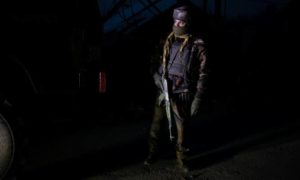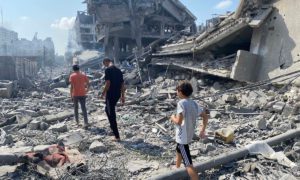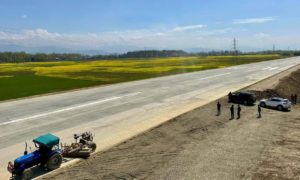Be it when he sacrificed sheep ‘in the town’ defying Governor Jagmohan’s order, be it the rise of the Muslim United Front (MUF), or thrashing army men during crackdowns, the late cleric cum leader Qazi Nisar’s legend continues to evoke nostalgia, 24 years after his assassination.
Before he would find repeated mention in raging debates of the Indian Parliament, Qazi Nisar was a cult figure holding sway over masses in Kashmir. Among other things, the cleric was known for his fearless conduct. He demonstrated one such conduct during a protest against demolition of the Babri Masjid in 1993.
Amid heightened militarisation in Kashmir that year, he confronted army men by lifting his son on his shoulder, shouting, “let the first bullet pierce his body, then one would hit you!”
Vignettes of his valour are part of folklore now.
Many remember how he defied curfew on several occasions to lead the funeral prayers of slain civilians or how on a snowy night, he carried a dead rebel on his shoulder for almost half a mile.
Born in the summer of 1952, Dr. Qazi Nisar passed with a rebellious streak in his childhood itself. He was arrested a couple of times for leading student protest against the rulers of that time.
He was born to a father called “Fakhr ul Waizeen” – the pride of preachers – whose father was man who led the agitation against Dogra Empire in the Islamabad of Kashmir.
Years down the line, Qazi Nisar would wear this family defiance up his sleeve, as a badge of honour.

After pursuing his early education from Nusrat ul Islam in Islamabad, he topped the Class 10th board exams in 1968, in the state of Jammu Kashmir. He was the one of the leading scorers in Kashmir province in 1970 Class 12th board Exams.
He later pursed his studies from Aligarh Muslim University where his political activities came under scanner many a times. He completed his M.A and M.Phil from Aligarh Muslim University in Islamic Studies and also studied Law. He was awarded a Gold Medal for his brilliant record in studies and earned his PhD in 1985. He also studied at Al-Azar University in Cairo, Egypt.
He was granted a job as a professor at the University of Kashmir, Department of Arabic; however he quit it and came down south “to serve people who need it the most.”
In early 1985, Dr. Qazi Nisar decried the ‘caste on my plate’ ban and openly sacrificed animals in defiance of Governor Jagmohan’s ban on the consumption of meat during a Hindu festival. Subsequently he was jailed for more than six months.
Following the 1986 communal riots in southern Kashmir, Qazi Nisar rebelled against governor Jagmohan’s dictate to suspend two high rank Muslim administrative officials. The two officers were reportedly suspended after they “refused to fire upon protesters”.
But as he protested at the town square of Islamabad, he was stoned by some communal miscreants at Goji Mohallah on a Friday morning.
Qadri Sahab, the then head preacher of Jamia Ahli Hadith Islamabad, protested against the stoning on “his Mirwaiz”. Both came out in a united protest and formed Ummat e Islami in 1986.
What followed is history.
This union led to united prayers. On the first Friday, prayers would be offered in Eidgah Ahli Hadith and then the next Friday would be offered at Eidgah Hanfia.
Itehaad ul Muslimeen chief, Moulana Abbas Ansari was the first person to lend support and wanted this significant “union to be not confined to southern Kashmir.”
Many organizations led by the stalwarts like Dr. Ghulam Qadir Wani, Abbas Ansari and others supported the union.

History has it, that it was Dr. Ghulam Qadir Wani and Dr. Qazi Nisar who proposed the name Muslim United Front (MUF), which was later accepted by all. Along with Prof. Bhat, the two of them formed a committee for drafting the Muslim Muthaida Mahaz constitution.
Some parties within MUF were more interested in ascertaining the cooperation of Dr. Qazi Nisar to achieve their political objectives as remarked by Shiv Ratan Mehta in Communication and Development: Issues and Perspectives, published in the year 1992.
Initially, it was decided upon that MUF will struggle for the rights of the oppressed Muslim community in Jammu & Kashmir; however the inclusion of some organizations, the “good friends of Mufti Sayeed” by late 1986 was merely to push MUF to contest elections and to destabilize the popular National Conference.
But being the central figure, there was a veritable MUF wave with him. Qazi Nisar was the magnetic force that pulled huge crowds with his brilliant oratory. Perhaps that’s why “he was the only leader who campaigned in all the seats and for all the contestants.”
After the mass-rigging in 1987 elections, he also faced the jail. Along with Abdul Gani Lone, Syed Ali Geelani, Maulvi Abbas Ansari and Prof. Abdul Gani Bhat, Qazi Nisar was released in April 1992 and made some efforts to give a political orientation to the ‘movement’ as international community kept plunging into darkness.
He was closely linked to Amanaullah Khan, one of the founders of JKLF. One of the first letters of initiating the armed rebellion was drafted to Dr. Qazi Nisar by the late exiled leader.
His defining point came when his influence transgressed the limits of regions and sentiments, besides boundaries of caste and gender. He had followers in Kishtawar, Doda, Baderwah of the Jammu Province or the far flung areas of southern Kashmir.
Such was his influence among militant groups that he was able to negotiate the release of two abducted British tourists namely Kim Housego and David Mackey in less than an hour in 1994.
The vision behind the mediation was that Kashmir issue will get a bad image internationally if the tourists are kidnapped or killed.
But he shortly became a victim of propaganda. It was the same negative campaign that earlier saw top leadership and intelligentsia across Kashmir being assassinated.
Those assassinations, intriguingly, had been propagated as the holy act of “clearance of dirt” by some gunmen who had been turned collaborators by the deep state and had been working on their payrolls.
Even some journalists, politicians, writers became a part of this ‘process of cleansing’.
Bhim Singh in his book “Flames in Kashmir” writes of an alliance between Dr. Qazi Nisar and Congress- which in fact did not exist. The author of the book had been jail mates with one of the key political figures being accused of the assassination. Behind the Singh’s spin was his grudge against the leader who had once declined to support him politically.
But when the ‘divisive’ assassination of Dr. Qazi Nisar was planned, Harkat Ul Ansar’s local commander Sikander, at the behest of the Intelligence Bureau (IB) had falsely fed information to a few Hizb gunmen that Dr. Qazi Nisar was stealing the mosque money and collaborating with the government to actively canvass against militancy (Adrian Levy and Cathy Scott-Clark, The Meadow).
Sikander refused to do so, as he was “well-aware” of the lies against the man whose killing he had been ordered. In fact, Sikandar came running to Qazi Nisar and informed him about this.
The cleric had famously told him, “The bullet that will pierce my body has my name carved on it.”
He was resolute in refusing police protection as he believed it would expose him to the graver risk of being spied upon.
“What security could we offer to the person who accuses police of spying upon him, he would even refuse to have a policeman in his vehicle,” Jagmohan quotes then DGP in his book, when seeking details about the intelligence reports of the planned execution.
But the killing was finally carried out by a few loose guns.
On the day of his assassination—19th June 1994—Islamabad plunged into bloody clashes between the two militant groups and that was the motive deep state sought to serve.

Many in the southern Kashmir were even forced to pay fines to Hizb for their ‘anti-movement’ activities (Jihadis in Jammu and Kashmir: A Portrait Gallery by K. Santhanam).
The locals by the end of their endurance against the atrocities committed, reacted bitterly by raising anti-Pakistan slogans. Many termed it an outburst triggered by the henchmen of Indian agencies.
Many pro-India gunmen flared up the fire by maintaining dual standards. They told Yusuf Jameel who had come to cover the funeral of Dr. Qazi Nisar to ‘set the straight record for BBC’.
Some journalists were told that they had no role in the killing. On the other hand, Abdul Gani Lone who condemned the brutal murder was bundled out of his car in Islamabad by some gunmen.
The locals say besides dozens of militants who gave gun salute to the slain leader, people from all walks of life, from many corners of India, Iran, Egypt came to get a last glimpse of the slain leader whose corpse lay in the Eid Gah for more than 24 hours and for three days funeral prayers were being offered constantly.
After the assassination, the government forces passed a resolution stating that, this “favourable situation should not be allowed to be frittered away.”(JPRS Report: Near East & South Asia – Issue 94048.)
With the result, those who even listened to the audio tapes of the brilliant orator, Dr. Qazi Nisar were tortured, interrogated, thrashed and threatened. His cadres throughout villages were suppressed, many were killed — creating a gap that still remains un-bridged.
Views and opinions expressed in this article are those of the author’s and do not necessarily reflect the editorial position and policy of Free Press Kashmir.
Like this story? Producing quality journalism costs. Make a Donation & help keep our work going.








